Artists with limited mobility can find freedom with accessible easels like tabletop models, floor-to-bed adjustable systems, or the versatile Access Easel. Look for key features including adjustable height/angle settings, stability, and convenient supply storage. Position your easel perpendicular to light sources and guarantee ample space for mobility devices. Consider DIY modifications like custom extensions or hydraulic lifts to enhance functionality. Discover how these adaptive tools not only support your artistic expression but can offer therapeutic benefits too.
Why Accessible Easels Matter for Artists With Limited Mobility
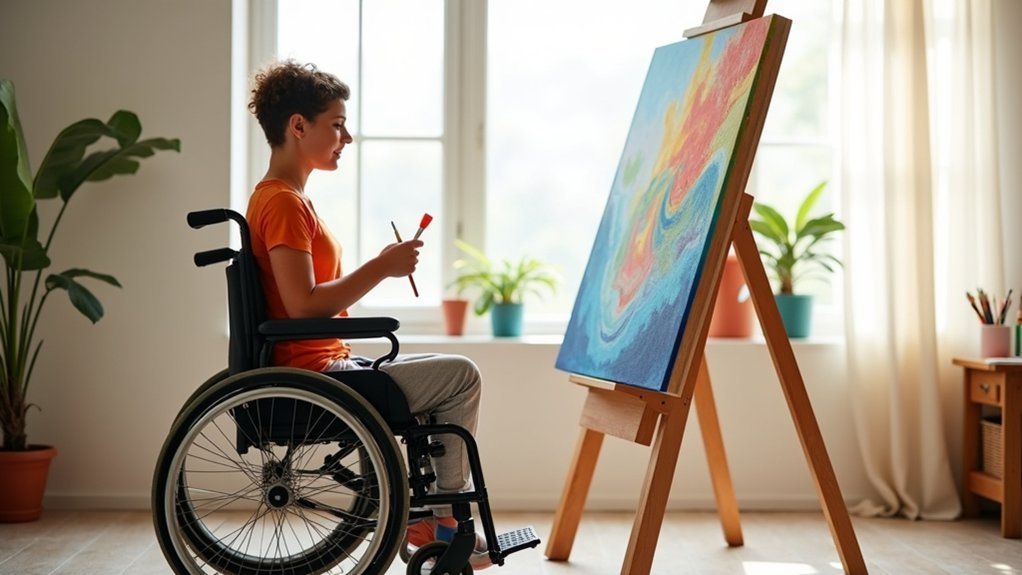
When creative expression meets thoughtful design, the result can be transformative for artists with limited mobility. Accessible easels open doors to artistic participation that might otherwise remain closed, promoting inclusivity in creative spaces.
Art becomes universal when design eliminates barriers, creating pathways to expression for every creative voice.
You’ll find these specialized easels offer adjustable heights and tilt mechanisms that reduce physical strain, allowing you to work without uncomfortable neck or back positioning.
They’re designed to support your independence, letting you create from your preferred seating position, whether that’s a wheelchair or specialized chair.
The customizable nature of accessible easels means you can configure them to meet your specific needs.
This personalization doesn’t just make art possible—it makes it comfortable, extending your creative sessions and enhancing your enjoyment of the artistic process. These easels often include convenient shelves or trays for easy access to your painting supplies while working.
Types of Adaptive Easels for Different Physical Needs
If you’re an artist with limited mobility, tabletop easels offer accessible solutions that can be placed on any flat surface within your reach.
Floor-to-bed adjustable systems provide versatility by extending over wheelchairs or beds, allowing you to paint comfortably without changing position.
These specialized options feature height-adjustable mechanisms and flexible positioning, making artistic expression possible regardless of your physical constraints. The Access Easel specifically accommodates various positions including sitting, standing, lying down, providing enhanced creative freedom for disabled artists.
Tabletop Mobility Solutions
Why struggle with traditional easels when tabletop versions offer superior accessibility for artists with limited mobility? These compact easels provide adjustable height settings, allowing you to create comfortably while seated in your preferred position.
Look for foldable models like the ARTIFY Adjustable Beechwood Tabletop Painting Easel that can be easily stored when not in use. Many feature removable components that reduce weight for easier transport.
You’ll appreciate the stable drawing surface and ergonomic design that reduces strain during creative sessions. The Blick Studio Adjustable Activity Easel offers height adjustable features that make it particularly suitable for artists with different accessibility needs.
The best tabletop easels include secure paper holders with soft plastic clips for those with limited dexterity, and adjustable paint tray positioning for wheelchair accessibility.
These versatile tools can be placed on any flat surface, giving you freedom to create wherever you’re most comfortable.
Floor-to-Bed Adjustable Systems
Three key features make floor-to-bed adjustable easels essential for artists with limited mobility: versatility, independence, and comfort.
These systems bridge the gap between standard easels and specialized mobility equipment, allowing you to create art whether you’re in bed or seated in a chair. Some models offer adjustable height features that can expand from 36 to 48 inches, accommodating various user positions.
With height-adjustable mechanisms, you can:
- Position your workspace effectively – adjust the height and angle to reduce physical strain while maintaining stability
- Access your supplies easily – integrated storage trays keep materials within reach without requiring assistance
- Adapt to changing needs – lightweight, foldable designs move with you as your position or location changes
These adaptive easels integrate seamlessly with other assistive technologies, from ergonomic brush handles to positioning devices, enhancing your creative experience regardless of physical limitations.
Key Features to Look for in Mobility-Friendly Art Setups
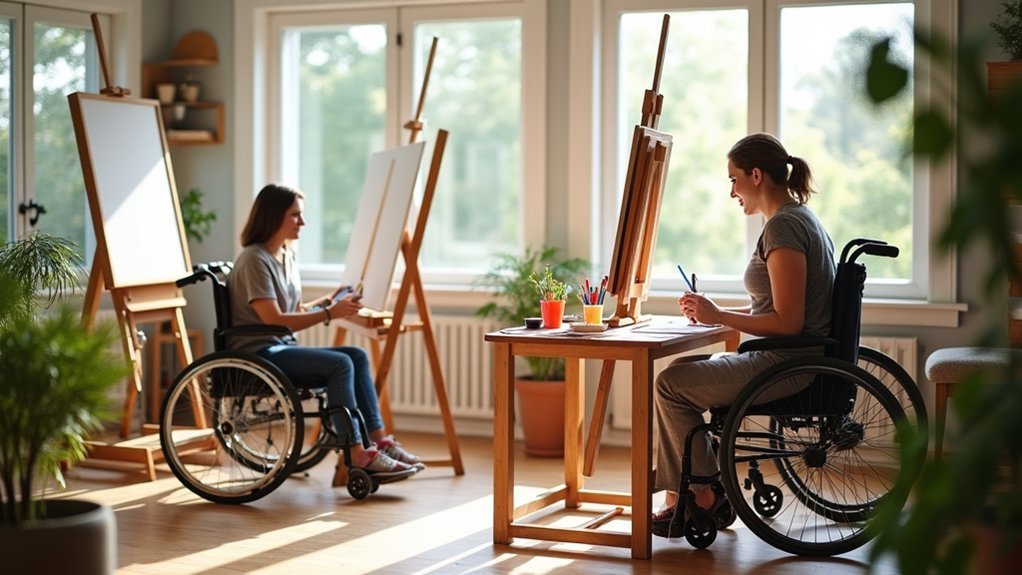
Creating accessible art environments requires careful consideration of equipment design and functionality. When selecting an art easel, prioritize adjustable height and angle features that accommodate your specific mobility needs.
Look for stability with non-slip surfaces to prevent accidents, especially if you use mobility aids. Choose setups with clear pathways around them for wheelchair access and consider easels with integrated lap trays.
Ergonomic designs with comfortable handles and supportive tools will reduce strain during extended use. For additional accessibility, seek systems with tactile materials and visual clarity aids.
Don’t overlook practical elements like adequate lighting and nearby seating options. The ideal mobility-friendly art setup should adapt to various mediums while integrating assistive technology that enhances your creative experience. Providing sufficient space (1.3 metres) around your easel setup ensures those using mobility equipment can navigate comfortably during art sessions.
Therapeutic Benefits of Art Creation for Mobility Challenges
Beyond selecting the right equipment, engaging in artistic expression offers powerful therapeutic benefits for those with mobility challenges.
Art creation becomes a pathway to emotional well-being, cognitive health, and social connection despite physical limitations.
Through art, we transcend physical boundaries to find emotional healing, mental stimulation, and human connection.
When you create art, you’ll experience:
- Emotional release – The creative process triggers endorphins and provides non-verbal expression options, helping you process feelings that might otherwise remain bottled up.
- Cognitive stimulation – Artistic focus enhances neuroplasticity and mindfulness, diverting attention from limitations while strengthening memory and problem-solving skills.
- Social engagement – Art therapy, especially through digital platforms, breaks isolation barriers by connecting you with communities and collaborative projects regardless of mobility constraints. Digital art tools are particularly valuable for widening therapy’s reach to diverse client groups who may struggle with traditional art materials.
These benefits extend far beyond the canvas, positively impacting your overall quality of life and psychological resilience.
Setting Up Your Creative Space: Positioning and Environment
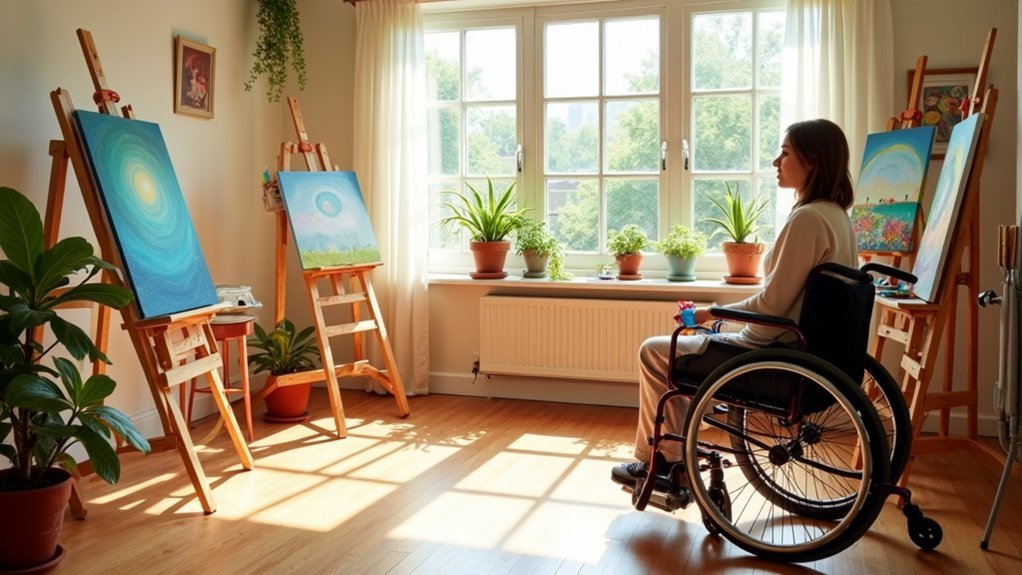
Maximizing your creative workspace becomes essential when mobility limitations affect your artistic practice. Position your easel perpendicular to light sources to reduce glare while ensuring it’s adjustable for your comfort. Keep supplies within easy reach to minimize movement and maintain workflow efficiency. Consider using Studio H-Frame easels for greater stability if you need more support while painting.
| Aspect | Recommendation |
|---|---|
| Lighting | Use natural light with daylight bulbs to supplement |
| Easel Placement | Align with your dominant side for ideal reach |
| Workspace | Allow ample room for mobility devices around easel |
| Organization | Use accessible storage solutions within arm’s reach |
Tilt your easel to access different canvas areas easily and consider automated adjustments if available. Manage cables carefully to prevent tripping hazards. Remember that a well-organized environment with proper lighting and ergonomic tools greatly enhances your creative experience and reduces physical strain.
Custom Modifications and DIY Solutions for Existing Easels
You can transform standard easels into accessible tools with simple modifications that enhance adjustability and stability.
Table-mounting your easel creates a stable workspace without requiring floor space, while strategic clamps and supports improve access angles for seated artists. Adding counterbalanced arms to your setup enables effortless height adjustments that accommodate changing energy levels and physical needs.
Consider using wall-mounted or door-hanging options when space is limited, allowing you to paint comfortably while preserving valuable floor area.
Adjustability Hacks
When standard easels don’t meet your specific mobility needs, creative modifications can transform them into personalized art stations. With a few adjustments, you can create a setup that works for your specific requirements and limitations.
- Enhance mechanical adjustability by adding hydraulic lift systems for smooth vertical movement or installing wheels with locking mechanisms to reposition your easel easily from a seated position.
- Modify mounting angles using adjustable tilt mechanisms that support different working postures—whether you’re sitting, standing, or reclining—to reduce strain during extended creative sessions. Integrating wood dowels or similar materials can create custom extension tools that increase your reach to all areas of the canvas.
- Improve grip and control by attaching long-handled levers to adjustment points, customizing knobs with larger grip surfaces, or integrating switch-activated motors when manual adjustments are challenging.
Table-Mounting Techniques
Transforming standard easels into table-mounted workstations opens up new possibilities for artists with limited mobility. You can greatly enhance stability by adding weight to the base or utilizing non-slip mats underneath your easel on smooth surfaces.
Consider installing tabletop hooks by notching the bottom of easel feet to prevent sliding, or use clamp systems to secure the easel firmly to your table edge. DIY brackets offer customized security for your specific setup. Building your own tabletop easel with hinged plywood pieces can provide an affordable alternative when commercial options aren’t suitable.
For existing easels, wooden blocks provide simple height adjustments, while quick-release plates enable rapid attachment to tables or tripods.
Enhance accessibility with tilt mechanisms that allow you to position your work at comfortable angles. Anti-tip brackets and proper weight distribution are essential safety features that prevent accidents while you’re creating art.
Space-Saving Adaptation Strategies
Artists with limited mobility often face challenges with traditional easels that consume valuable space in already constrained environments. You can implement custom modifications that transform existing easels into accessible tools without sacrificing precious room.
- Height adjustments – Modify your easel with adjustable legs to accommodate wheelchairs or preferred seating. This customization guarantees you’ll position your canvas at a comfortable height, reducing strain during extended sessions. The Mabef Painting Workstation Easel M-30 offers an excellent example of a pre-designed solution with integrated workstation features specifically designed for artists in wheelchairs.
- DIY solutions – Create custom brackets using wooden dowels or PVC pipes to secure your canvas. These affordable modifications can be tailored to your specific needs and installed on low tables for seated access.
- Innovative placement – Position your easel on existing furniture like shelves or tables to maximize space while maintaining accessibility from your preferred working position.
Success Stories: Artists Thriving Despite Physical Limitations
Despite facing significant physical challenges, countless creators have developed remarkable careers in the art world through innovation, technology, and sheer determination.
Chuck Close transformed paralysis into an opportunity, pioneering grid-based compositions that defined photorealist painting. Henri Matisse embraced cut-out art after becoming wheelchair-bound, creating some of his most celebrated works.
Today’s artists continue this tradition of adaptability.
Wiley Johnson, an autistic artist, has his work displayed in banks and galleries through ArtLifting’s platform. After persevering through periods of hospitalization and restraints, Johnson found his artistic voice through art therapy in 2009. Neil Harbisson, born without color vision, uses an antenna to “hear” colors, creating unprecedented art forms. Danelle Malan leverages digital tools to overcome physical limitations.
These success stories demonstrate that with proper tools, support systems, and adaptive techniques, physical limitations often become catalysts for artistic innovation rather than barriers.
Resources for Funding and Acquiring Adaptive Art Equipment
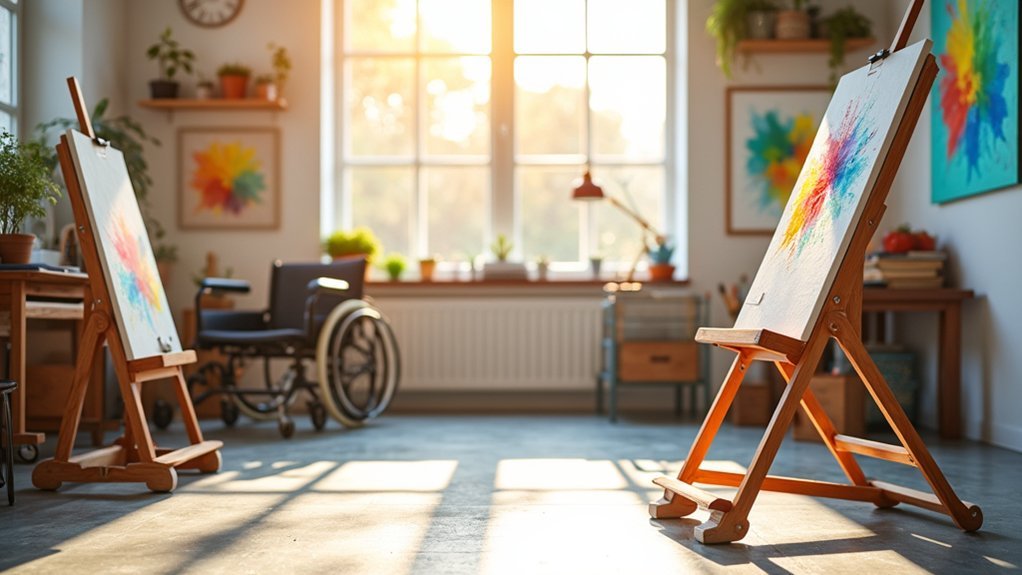
While pursuing art with limited mobility presents unique challenges, acquiring appropriate adaptive equipment shouldn’t be an insurmountable financial burden. National organizations like the National Endowment for the Arts and foundations such as the Andrew W. Mellon Foundation offer grants specifically for enhancing accessibility in the arts.
For practical assistance in finding and funding adaptive art equipment:
- Explore state arts agencies and community-based grants, which often prioritize accessibility projects with less competition than national programs.
- Contact assistive technology manufacturers who may offer discounts or payment plans for specialized easels with adjustable heights.
- Consider crowdfunding platforms like Kickstarter or GoFundMe to engage your community in supporting your artistic journey.
Don’t overlook UCLA’s National Arts and Disabilities Center, which provides specialized resources for artists with mobility challenges. The Kelly Brush Foundation’s Individual Grant Program could be a valuable resource for artists with spinal cord injuries looking to increase their participation in adaptive arts activities.
Frequently Asked Questions
How Long Do Adaptive Easels Typically Last With Regular Use?
With proper care, your adaptive easel can last 5-10 years under regular use. You’ll extend its lifespan by tightening screws, keeping joints clean, and not exceeding the weight capacity.
Can Children With Mobility Challenges Use the Same Easels as Adults?
Yes, you’ll find that children with mobility challenges can use the same easels as adults when they’re adjustable. Many easels offer height customization and adaptable features that accommodate users of all ages.
Are There Portable Options for Travelers With Mobility Limitations?
Yes, you’ll find several portable easel options that work well for travel. Look for lightweight, collapsible designs with adjustable heights, carrying bags, and stable bases that can accommodate sitting or standing positions.
What Maintenance Is Required for Electronic or Mechanical Easel Components?
You’ll need to check and replace batteries regularly, protect cables from damage, lubricate hinges, inspect for wear, and keep surfaces clean. Don’t forget to unplug electronic components before cleaning to avoid electrical hazards.
How Do Different Art Mediums Affect Easel Selection for Limited Mobility?
Different art mediums influence your easel choice based on weight and stability needs. You’ll want adjustable height and tilt for watercolors, sturdy support for acrylics, and accessible tool storage for pastels or digital work.
In Summary
Finding the right art easel isn’t just about equipment—it’s about reclaiming your creative independence. You’ve got options that work with your unique needs, not against them. Don’t let limited mobility restrict your artistic vision. With proper tools and setup, you’ll express yourself freely again. Remember, art-making isn’t just therapeutic—it’s transformative. Your creative journey continues, regardless of physical challenges.

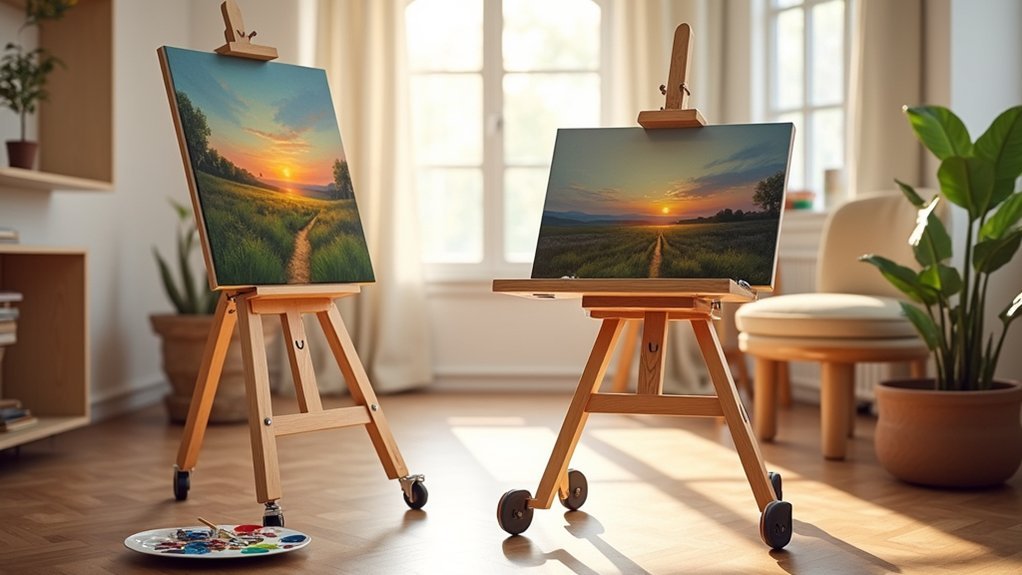



Leave a Reply